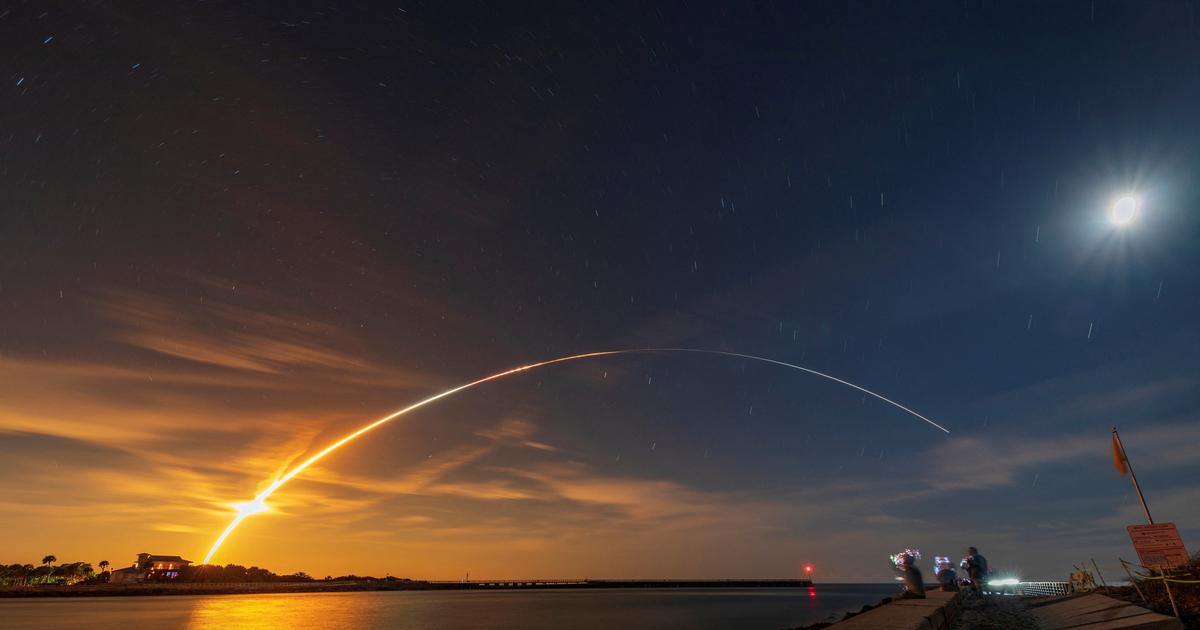
In the pictures, in the pictures – The Orion capsule, which has traveled just over 432,000 km from Earth, is due to land this Sunday at the end of the afternoon.
After spending 25 days in space and flying over the moon, Orion space capsule Artemis’ mission is to return a land. Its landing is scheduled for Sunday, December 11 at 5:40 pm GMT (6:40 pm French time), in the Pacific Ocean, off California. Named after the goddess of the moon, the Artemis mission has ventured just over 432,000 kilometers from our blue planet. Record of habitable vessel.
If there is no one inside this ship – but Three models and a stuffed sheep – This experiment aims to prepare manned flights to the moon, and then to Mars. A look back at this extraordinary mission, 50 years after the last flight of the Apollo program.
preparations
It took ten years and Very expensive tuning to build this 98-meter-high giant. The rocket is called the Space Launch System (SLS). Its development is a direct result of The Space Shuttle Columbia accident in 2003This caused the death of seven astronauts.
Initially, it was scheduled to take off on August 29, 2022. But the launch was postponed several times to solve technical problems, but also to avoid two hurricanes, Ian and Nicole.
Read alsoThomas Pesquet: “We are working on a sustainable return to the Moon”
The third attempt was successful. This photo was taken three days before liftoff, on November 13, 2022. The rocket was placed on Launch Pad 39B at Cape Canaveral Launch Base in Florida.
More than 100,000 people are expected to walk Florida beaches to watch the shooting. Here, a photographer waits at the Kennedy Space Center press location on November 15, 2022, the day before launch.
November 16: take off
The rocket finally launched on Wednesday, November 16, at 01:47 local time and 06:47 GMT, from Kennedy Space Center. Maximum take-off thrust was rated at 4,000 tons, which is three times more powerful than the Ariane rocket, and 15% more than the Saturn V rocket in the Apollo programs.
The SLS rocket rose into the night like a giant fireball from the Kennedy Space Center. The two white boosters—which initially provide most of the thrust—stopped two minutes after liftoff.
After eight minutes, it is the turn for the main stage (orange) body to separate, leaving the Orion capsule and its service module attached to the second stage. This made a long push of about an hour and a half long to put the ship on course for the Moon.
Finally, before completing its mission, the second stage placed about a dozen small satellites on different trajectories.
November 16th to December 5th: Heading to the Moon
After adjusting its trajectory, the Orion capsule headed towards the Moon in order to proceed with its flight. It took about five days to reach it.
Then it ignited its engines to put itself into a long-range retrograde orbit and completed one and a half turns of the Moon, venturing 450,000 km from Earth, a record for a habitable spacecraft – farther than the Apollo missions. . During the mission, Orion spent about six days in distant orbit around the Moon.
December 5: Moon flyby and return to Earth
On Monday, December 5, nearly 20 days after liftoff, the Orion space capsule made its flyby of the Moon. Communication with the capsule was lost for 30 minutes as it passed behind the far side of the moon.
By making this close flyby of the surface, the spacecraft took advantage of the moon’s gravitational pull to propel itself on its return trajectory. Its heat shield, the largest ever, was put to the test by withstanding a temperature of half the surface height of the sun as it passed through the atmosphere.
Read alsoThe Artemis Mission: How NASA Returned to the Moon
When the capsule returns to Earth, it will have traveled more than 2.2 million kilometers in total, said Mike Saravin, mission manager.
50 years ago, it was the last Apollo mission
On December 7, 1972, the Apollo 17 mission launched to the Moon. Astronauts Eugene Cernan and Harrison Schmidt are the last two to walk on the moon.
At that time, the United States and the USSR made the occupation of space a major issue in the Cold War. Against the Soviets, the Americans proved stronger, sending six missions and 12 men to the moon between 1969 and 1972.
In this vintage photo, Apollo 17 astronauts Harrison Schmidt, left, Eugene Cernan, right, and Ronald Evans, center, stand in front of the Apollo 17 lunar travel module, at the Launch Complex on August 28, 1972, at Kennedy Space Center.





